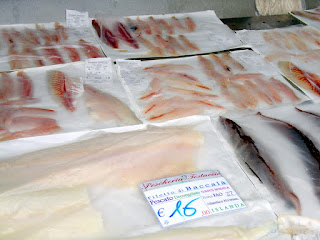It's been at least 4 years since the residents of Testaccio in Rome have had their daily market moved to an indoor venue 6 blocks from its former location on Via Luca della Robbia. For many years the old outdoor market suffered during inclement weather for lack of customers and discomfort for the vendors. The new building changes all that and even offers underground parking. Although this market has long hosted residents from all over the city, it is now easier for non locals to shop there. I'm pleased to be part of that group.
The primary purpose of the mercato
is to supply fresh poultry, fish, pork, beef, cold cuts and produce to the neighborhood. The poultry can be quite varied as seen in this photo.
Now that the stalls have a roof over them, vendors are upgrading methods of keeping their products in better condition. For example, the fish monger can keep flies off his seafood by covering it with parchment paper that will not blow away in the wind.
Most of the meats are now in permanent, refrigerated cases that keep them at optimum temperatures. This provides not only for preserving freshness, but eliminates any worry one might have about contamination from insects and bacteria. That's a big improvement.
When renting apartments in Italy, I have occasionally cooked more than breakfast. This rib roast caught my eye, but the fantasy of a full dinner diminished as I imagined trying to clean an oven. If I was convinced it was Chianina beef, the fantasy may live on, but I'm not certain that it's sold outside of Tuscany.
Rome, like most of Italy, is pork centric, so you see it in many forms while you stroll through the mercato.
In this photo, there appear to be a combination of pancetta, the Italian, non smoked bacon; ham, and guanciale. The round, fatty piece is guanciale, the cured pig jowl that is traditionally used in a traditional Carbonara recipe.
Fruits and vegetables abound in the market and are interspersed with many of the other items sold there. It would be easier to shop if all products of a like kind were in the same area.
As things stand, there is a loose affiliation between food groups along with prepared foods. But you are bound to find exceptions with general merchandise in the mix.
Prepared foods are
putting in a strong showing too.
Today I saw a white Veal Ragu that looked every bit as good as those
I've seen in restaurants. It was so entrancing, I failed to take a
photo.
Prepared, although not precooked, the polpette (meatballs) in these photos are at the very least a convenience food in Italy. Those below are actually cooked and ready to heat and serve.
Plenty of vendors are prepared to part with baked goods including pastries, biscotti, rolls, breads and the ever favorite, here in Rome, Pizza Bianca, the Roman answer to focaccia. Even better, are the pizze with various toppings.
I highly recommend that anyone who has never tried a squash blossom nor a porcini mushroom "bianca" style pizza (without tomato sauce) give it a try here. They're two of my favorites, even though I still like the zucchini, as well as the potato and rosemary versions.
The typical pizza bianca, as well as the other pizze, may appear to have a cracker like exterior, but there's a factor of chewiness inside that raises them to another level. Pizza Bianca with its drizzled olive oil surface is delicious on its own, but even better when paired with any of the cold cuts and cheese sold at the mercato.
Gourmet shops selling these types of panini abound in Testaccio. So buy your own ingredients at the market or let someone else make one for you, but don't miss trying some.


Mercado Testaccio is also home to many shops selling clothing, shoes and handbags. Some are vintage, others sell only accessories, jewelry or leather goods. All live happily under one roof.
On my most recent trip, I discovered Bee Joux, a shop selling women's accessories, including Italian leather purses and French jewelry. Even though I try to buy locally made products, the jewelry was too tempting, so I succumbed and bought a set, deluding myself into thinking it was still okay, since I had been to France on the same trip.
The tables with clothing piled high on top, with a bargain basement appeal, attract many customers, no doubt hoping to find an under priced treasure, but I couldn't bring myself to memorialize them with a photo.
If American vintners are willing to sell wine in boxes, how can I criticize Italian wine served up in plastic bottles? Whether bringing their own bottles, or purchasing a plastic bottle at the wine shop, Italians can satisfy their love of wine locally by paying for it by the liter. Casks of wine from all over Italy can be found at wine shops in Rome.




















